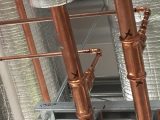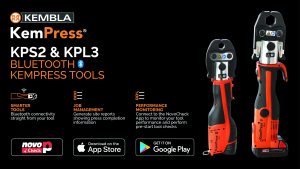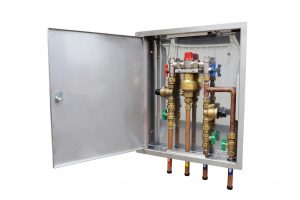Nothing stands still and plumbing is no exception says John Fennell.
We live in an ever changing world where we must continually improve, and look for smarter and better ways to do things. Plumbing is no exception as products and regulations constantly get modified and updated, and it’s crucial that we stay on top of any changes.
Lead-Free
One example of change is our awareness of the issues with lead and its impact on human health. It has been 30 years since lead soldering of copper plumbing has been prohibited in Australia and we are seeing another change just around the corner where brass fittings will be moving to low-lead alloys to help eliminate lead in our drinking water.
Brass fittings can currently have a relatively small amount of lead (<4%) and generally this is trapped in the metal, however with aggressive waters and some non-conforming products some lead can leach into the water. Moves are under way here in Australia to further restrict lead content to <0.25% within the next few years. This is a good thing, but plumbers will notice that different techniques are required when brazing these new fittings as they have a lower thermal conductivity and more heat needs to be applied to the fitting before applying the brazing alloy. In other words you must be prepared to learn different methods.
Press-Fit
Copper plumbing has adopted the Press-Fit and Push-Fit with much vigor in order to allow faster and easier installation as well as being a safer flame free method. With these new fitting there are new tools and methods that must be learnt, but as with any new product some problems can occur.
An incorrectly or un-pressed Press-Fit fitting can and does allow leaks that could have major consequences. To overcome this suppliers have regular training sessions to help plumbers understand and overcome these issues. There are also different work procedures and techniques that can be employed to help eliminate some of these issues.
Such things as marking a completed fitting to validate a pressed fitting and the use of ‘smart ’pressing tools that can record the number of correctly pressed joints. Kembla has the KPS2 and KPL3 tools that are now equipped with Bluetooth connectivity so you can track your press and tool performance anytime using the NovoCheck app on your smart phone or tablet. It is also necessary to have your pressing tools services and calibrated at regular intervals and most tools have a warning system to alert you when this is necessary.
Don’t forget the seven steps in performing a good Press-Fit job:
1. Debur inside and outside of the cut ends of the tube
2. Mark the insertion depth
3. Ensure you have the correct fitting
4. Ensure the O-rings are present and in good condition
5. Check the pressing jaws and make sure they are clean and free of debris.
6. Before activating the pressing jaws make sure they are straight and are correctly positioned over the raised section of the fitting
7. After pressing inspect the fittings to ensure the press has been completed and it is a good idea to mark the completed fitting so as to verify it has been checked.


Design Methods
Water conservation is another initiative that is important in today’s modern world and there are impacts on plumbing that need to be understood.
Low flow taps, WELS rated appliances such as water saving toilets and even waterless urinals mean that the traditional hydraulic design methods need to be modified. The use of rainwater and grey water for toilet flushing and other uses further reduce the demand on water usage in new houses. It is just as problematic to have oversized pipework as it is to have undersized pipework so modified design methods need to be considered.
With heated water new or modified heated water systems must be temperature limited and there are several ways of achieving this with the primary methods being by Thermostatic Mixing Valves (TMVs) or Tempering Valves. Plumbers must have a special license for testing, commissioning and maintenance of TMV’s so more training is needed.

ATMS719PRVSF-430 with ATMSHL-430 : Aquablend 1500 valve with PRV, SmartFlow, Cold water by-pass, hinged lid Featuring Enware’s unique thermal flush technology
Larger installations are getting more complicated and often require the assistance of Hydraulic Consultants. Centralised circulating heated water system are very common but need consideration to ensure air is not trapped in high spots and all the sub-loops are properly balanced to allow even distribution of the hot water. The use of air-eliminating valves and balancing valve is imperative on complicated systems. All these special valves need to be maintained and serviced to ensure correct operation and fault finding is sometimes not easy unless you are properly trained.
Other heated water systems in larger installations may require point of use metering at every apartment or have no centralised heated water system at all relying on instantaneous water heater in every apartment. The choices are many and making the best decision requires training and experience.
New skills and Training
All plumbers need to keep abreast of these new regulations and developments as the consequences can be very costly and have a major impact on your business. Every plumbers needs to be familiar with the National Construction Code and AS/NZS 3500 as well as State regulations. You need to include training as a critical activity of your business, and take advantage of all the services offered by suppliers and the industry.
There are many free areas where information can be obtained and the easiest of these is the internet. Young people are very familiar with this but they also need to ensure the information provided is accurate and complies with the regulations. Experienced plumbers need to learn these new systems and modern ways people are communicating.
Many suppliers are using the internet to show how to use their products and have their own on-line resources containing all the relevant information. Brochures and booklet are great, but for on the spot access to the information today’s smart phones and tablets are the way to go.
Social media such as YouTube, Instagram and Twitter are good for keeping up with the latest innovations, but it is the suppliers and manufacturers that will provide access to installation guides. You should also request on-site training on how to use new products and to keep your employees well trained. Refreshers sessions are just as important.
For larger jobs, some suppliers offer on-site installation audits of their products as it is just as important for them that things are working well. Industry organisations such as the Master Plumbers Association (MPA) and the Institute of Plumbing Australia (IPA) have good resources and these should be utilised and don’t forget another valuable source of information is the Plumbers Connection Magazine. The ICAA also regularly revises the Plumber Handbook and the Hydraulic Services Design Guide, to ensure that they are up to date, and these are available free from our website (copper.com.au).
Lastly you need to be aware of the warranties of the products you are using and ensure you as a plumber are covered. If not your insurance may not cover you and you will bear all the costs.